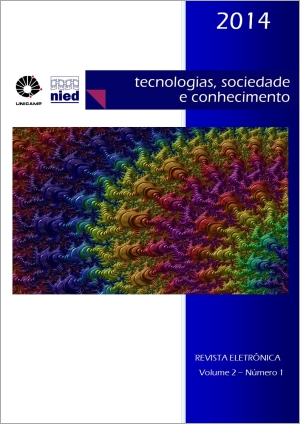Abstract
This work presents a softwarearchitecture model that supports content extension activities in Ubiquitous Learning Environments. As a proof of concept,we employed this model to build a Web application that allows the creation of comments and multimedia contentrating. This application was integrated to the Classroom eXperience platform and its use was assisted over two semesters. We applied an adaptation of the Technology Acceptance Model to examinereceptivity and impact of the new features over students. As a result, themodule was well received by users, who accessed the platform more than before. This incentive also contributed to increase student performances, showing that interactive features encourages collaborative learning and promotes teaching/learning processes in the educational field.
References
Araújo, R. D. et al. Personalization of Interactive Digital Media in Ubiquitous Educational Environments. IEEE International Conference on Systems, Man, and Cybernetics, 2013.
Araújo, R. D. et al. Autoria automática de objetos de aprendizagem a partir de captura multimídia e associação a estilos de aprendizagem. Simpósio Brasileiro de Informática na Educação, 2014.
Azouaou, F. et al. WebAnnot: a learner’s dedicated web-based annotation tool. International Journal of Technology Enhanced Learning, v. 5(1), p. 56-84. 2013.
Banday, M. T. e-Learning, Web 2.0 and beyond. IEEE International Conference on Digital InformationProcessing and Communications, 2012.
Barbosa, J.et al.Computação Móvel e Ubíqua no Contexto de Uma Graduação de Referência. Revista Brasileira de Informática na Educação, v. 15(3), p. 53–65, 2007.
Chen, Y.-C. et al. Development and evaluation of a Web 2.0 annotation system as a learning tool in an e-learning environment. Computers & Education, v. 58(4), p. 1094–1105, 2012.
Claros, I. & Cobos, R. Social Media Learning: An approach for composition of multimedia interactive object in a collaborative learning environment. IEEE International Conference on Computer Supported Cooperative Work in Design,2013.
Davis, F. D. A technology acceptance model for empirically testing new end-user information systems: theory and results. Tese de Doutorado. Massachusetts Institute of Technology, 1986.
Fan, P.-L. et al. An Online Collaborative Learning Platform with Annotation on Figures. IEEE International Conference on Advanced Learning Technologies, 2010.
Ferreira, H. N. M. et al. Classroom Experience: A Platform for Multimedia Capture and Access in Instrumented Educational Environments. Brazilian Symposium on Collaborative Systems, 2012.
Ferreira, G. L. et al. Um Modelo de Recomendação Ubíqua de Conteúdo para Grupos de Aprendizes. Simpósio Brasileiro de Informática na Educação, 2013.
Foll, S. et al. Classifying Multimedia Resources Using Social Relationships. IEEE International Symposium on Multimedia, 2006.
Gartner. Gartner Says Worldwide Traditional PC, Tablet, Ultramobile and Mobile Phone Shipments On Pace to Grow 7.6 Percent in 2014. Disponível em: http://www.gartner.com/newsroom/id/2645115. Acesso em: jun. 2015.
Huang, J. L. et al. Detecting and Deterring Insufficient Effort Responding to Surveys. Journal of Business and Psychology, v. 27(1), p. 99–114, 2011.
Ismail, L. S. Extensible multimídia document player. International Conference on Computer Engineering & Systems, 2009.
Khan, J. I. &Tao, Q. Prefetch scheduling for composite hypermedia. IEEE International Conference on Communications, 2001.
Kostakos, V. & Ferreira, D. The Rise of Ubiquitous Instrumentation. Frontiers in ICT, v. 2, 2015.
Lin, J.-L. & Hwang, K.-S. An automatic classification system of online E-learning resources. International Conference on System Science and Engineering, 2012.
Lopes, J. et al. Towards a distributed architecture for context-aware mobile applications in UbiComp. Brazilian Symposium on Multimedia and the web, 2013.
Mendonça, I. E. S. et al. Explorando Funcionalidades Sociais e Colaborativas em Ambientes Educacionais Ubíquos. Simpósio Brasileiro de Informática na Educação, 2014.
Möller, D. P. F. et al. Ubiquitous learning: teaching modeling and simulation with technology. Grand Challenges on Modeling and Simulation Conference, 2013.
Morgado, E. M. et al. Learning Objects classification for competency-based skills. International Symposium on Computers in Education, 2012.
Mukherjee, S. et al. Challenges of establishing a collaborative learning environment using MANET. International Conference on Business and Information Management, 2014.
Peris, M. et al. Acceptance of Professional Web 2.0 Platforms in Regional SMENetworks: An Evaluation Based on the Unified Theory of Acceptance and Use of Technology. Hawaii International Conference on System Sciences, 2013.
Pimentel, M. da G. et al. Supporting Educational Activities through Dynamic Web Interfaces. Interacting with Computers, v. 13(3), p. 353–374, 2001.
Rauniar, R. et al. Technology acceptance model (TAM) and social media usage: an empirical study on Facebook. Journal of Enterprise Information Management, v. 27(1), p. 6–30, 2014.
Sabitha, A. S. & Mehrotra, D. User Centric Retrieval of Learning Objects in LMS. International Conference on Computer and Communication Technology, 2012.
Settle, A.et al. Does lecture capture make a difference for students in traditional classrooms. Conference on Innovation and technology in computer science education, 2011.
Silva, L. C. et al. MobiLE: Um Ambiente Multiagente de Aprendizagem Móvel Baseado em Algoritmo Genético para Apoiar a Aprendizagem Ubíqua. Revista Brasileira de Informática na Educação, v. 21(1), p. 62–75, 2013.
Silva Santos, E. C. et al. A Study of Test Techniques for Integration with Domain Driven Design. International Conference on Information Technology -New Generations (ITNG), p. 373–378, 2015.
Truong, K. N. &Hayes, G. R. Ubiquitous Computing for Capture and Access. Foundations and Trends in Human–Computer Interaction, v. 2(2), p. 95–171, 2009.
Tseng, J. C. R. et al. A Collaborative Ubiquitous Learning Approach for Conducting Personal Computer-Assembling Activities. International Conference on Advanced Learning Technologies, 2010.
Wan, L. Application of web 2.0 technologies in e-learning context. International Conference on Networking and Digital Society, 2010.
Weiser, M. The Computer for the 21st Century. Scientific American, v. 265(3), p. 94–104, 1991.

This work is licensed under a Creative Commons Attribution 4.0 International License.
Copyright (c) 2015 Tecnologias, Sociedade e Conhecimento


